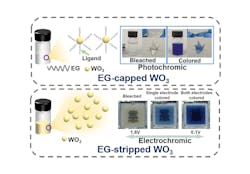Tungsten trioxide nanodots show promise for electrochromic and photochromic devices
Nanodots possess a large surface-to-volume ratio, which enables the insertion (intercalation)/removal of guest cations for electrochromic applications. So researchers from Shandong University in China and the University of Alberta in Canada are tapping tungsten trioxide (WO3) nanodots to enable rapid color switching in electrochromic devices—and the nanodots’ large surface-to-volume ratio accelerates proton intercalation under sunlight exposure to enhance the coloration speed of photochromic effects (see video).
Leveraging these properties, the team’s ligand-tailored WO3 nanodots show promising electrochromic performance. Their work is a truly interdisciplinary endeavor that integrates chemistry, materials science, and optics.
“WO3 nanodot colloids can reduce production costs and are promising for low-cost electrochromic devices,” says Haizeng Li, a professor of optics at Shandong University. “This is why we work on nanodots.”
Electrochromic/photochromic
Their electrochromic work revolves around guest cation intercalation-induced polaronic responses. “Essentially, our electrochromic devices embody electrochemical photonics that facilitate adjustable optical devices such as variable optical attenuators, optical switches, addressable displays, touch screen devices and, notably, energy-efficient smart windows for buildings,” Li explains. “As for our photochromic work, it involves photo-gated reactions that lead to the coloration effect.”
Most surprising aspect of this research? “The facile increase in the entropy of crystalline WO3 through a straightforward solution,” says Li. “To our knowledge, this is the first reported approach to enhancing the entropy of crystallized materials. It’s a moment that fills me with pride, knowing we’ve made the seemingly impossible possible.”
The team demonstrated “the use of WO3 nanodots within zinc anode-based electrochromic devices, which we pioneered,” says Li. “Our devices enable dynamic transparency control and electrical energy storage. Imagine that future dynamic windows can not only control the transparency, but also store energy like a battery.”
Beyond this, WO3 nanodots may find applications within photochromic hydrogels and textiles. “Photochromic hydrogels can adhere to regular glass to provide photochromic functionality,” Li says. “As for photochromic textiles, along with their photochromatic attributes they also offer radiative cooling properties that make them ideal for smart clothing.”
Following the synthesis of amorphous WO3 nanodots, the team’s next major challenges involve constructing high-performance zinc anode-based electrochromic devices. “Since we’re not chemists, we’ll need to delve into colloidal chemistry to tailor the ligands on the surface of the WO3 nanodots,” says Li.
Scaling production of tungsten oxide nanodots
During Li’s more than 10 years of electrochromic research, his goal has been to create low-cost electrochromic windows. “While our current work successfully synthesizes high-quality WO3 nanodot colloids, scalability remains crucial,” he says.
The team’s future work will focus on scaling up the production of these WO3 nanodots. “In our future photochromic hydrogel research, we aim to implement proper sealing techniques to ensure long-term stability,” Li says. “Similarly, for photochromic textiles, we aim to design washable variants to facilitate real-world applications.”
FURTHER READING
P. Liu et al., Adv. Funct. Mater. (Mar. 30, 2024); https://doi.org/10.1002/adfm.202400760.
About the Author
Sally Cole Johnson
Editor in Chief
Sally Cole Johnson, Laser Focus World’s editor in chief, is a science and technology journalist who specializes in physics and semiconductors.

